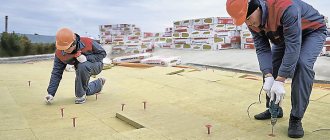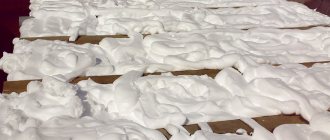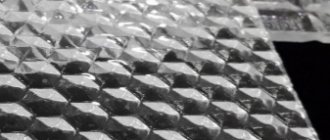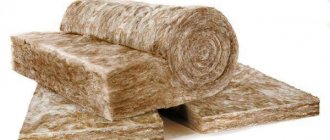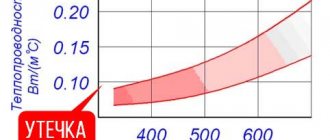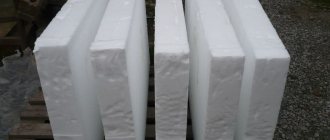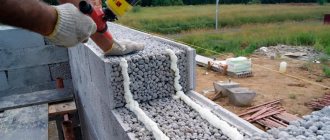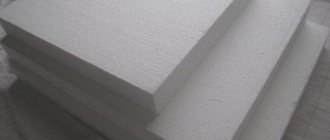Sasha built a frame extension to the house. I decided to insulate it with foam insulation. He built an extension because the old house did not have a hallway or a bathroom. The house was built in the 80s from brick.
Back then, our houses were built like this: brick walls with an air gap were built on the foundation. Then a roof was made, which was covered with slate.
A mixture of clay and flooring, 5-10 cm thick, was laid on the ceiling as insulation. To reduce heat loss at home, you need to insulate it. Then it will be possible to pay less for heating in winter and electricity in summer.
Summer in Kuban is hot and if the house is poorly insulated, the air conditioners will work almost around the clock.
When Sasha built the extension, he immediately decided that he would insulate the house and the extension with foam insulation. He saw on the Internet that guys were coming, drilling holes in the walls and pumping penoizol into them.
This is the best insulation option. If you insulate the house from the outside, you will have to make an additional façade. And this is a big expense.
I found through an advertisement the guys who blew foam insulation between the walls of an old house and into a frame extension. After 6 years, we had to dismantle the façade of the extension and when we saw what happened to the penoizol, then...
Although let me tell you about this a little later, for now I suggest you find out what penoizol is.
Staff
To service the production, you need to hire 3 people, one of whom will be a senior person in the workshop. The latter’s responsibilities include coordinating the rest of the workers, monitoring their activity and training. It is the senior worker who needs to be sent for an internship to the equipment seller.
To organize sales, you will need a sales manager. He will meet and negotiate supplies with representatives of construction and wholesale and retail companies.
A driver is needed to deliver raw materials to the factory and finished goods to customers.
The accountant will handle the document flow and prepare papers for the tax authorities. It is better to hire one through outsourcing (by contacting an accounting firm).
Moisture absorption
Today, many installers use penoizol in cylinders. This insulation is very easy to use. At the same time, thermal insulation has a high level of moisture absorption. It also releases it well into the environment. This allows you to maintain an optimal level of air humidity.
If penoizol gets wet, it dries quickly. At the same time, its original characteristics remain unchanged. This process does not affect the properties of the insulation in any way. It retains heat well in the room and does not ignite. The walls will not be damp. However, experienced installers recommend not to neglect high-quality ventilation.
The hygroscopicity of the presented insulation allows walls and finishing materials to deteriorate much more slowly. In this case, the insulation layer can absorb from 10 to 20% of moisture from the environment per day.
Production scheme and necessary ingredients
If the choice is made in favor of the second option, you will need to purchase drawings for assembling the structure and all its components:
- gas-liquid installation “standard”, which includes pumps, controls and settings, as well as a supply and mixing hose;
- containers for the production of penoizol: barrels for resin and foam;
- compressor for compressing air;
- a tank for electric water heating, which can replace a regular bucket with a boiler;
- working fluid heater;
- autotransformer: solves the problem when working in low voltage networks.
All parts of the kit are mobile and easy to transport. The equipment is assembled into a single complex at the construction site.
The main components of penoizol are:
- urea-formaldehyde resin - the liquid from which foam is formed;
- orthophosphoric acid - a hardener, thanks to which the foam hardens;
- foaming agent;
- technical water.
Supply of penoizol to the prepared zone The ingredients enter through the pump into the unit, where, with the help of compressed air, the components are mixed, foamed and transformed into an excellent thermal insulation material.
Next, the finished product is fed through a mixing hose at the point of use.
Necessary equipment
When working with liquid insulation, you will need the foam insulation itself, an apparatus, a metal profile with a drill and dowels. The special machine consists of 3 containers for water, hardener, and resin. When you turn on the device, the elements are mixed in a separate chamber. There the mixture foams from strong air pressure. Then it goes into the sleeve and fills the insulated openings.
There are several types of equipment for insulation procedures. This is a GZhU installation, Potok-2000DMU or Potok 3000/10UM from Logrus, Turbojet-6.
The GZHU is a cheap and easy machine to use.
The Potok series from Lorgus has a selection of simple machines, more complex and productive ones. The devices allow you to dose substances and regulate the flow rate. Which is very important during installation.

Compressor for the production of penoizol
Turbojet-6 (turbomechanical mixing) - there is a high-pressure mixture supply and a start-stop function (for better control of the supply of the substance).
Sometimes a lathing with a restrictive mesh is used.
The most effective expanded clay method
Budget options that can only be recommended for residents of warm regions were discussed above. To reliably protect the attic of a house in areas with the harsh Russian climate, it is necessary to use better and more effective methods. Among backfill materials, expanded clay is the best. This is a porous material that is obtained by firing clay (or its shale). It is light and has an oval shape. Regarding the form of release, fractions are distinguished: 5-10 sand, 10-20 crushed stone, 20-40 gravel.
Expanded clay is laid as follows:
Level the rough base (if necessary). Height differences of more than 1 cm are unacceptable. We lay a film of any thickness, the main thing is that there are no holes. Pour a cushion (no more than 10 mm) of gravel. Scatter expanded clay over the entire area and level it
It is very important to achieve uniformity. For convenience, you can use a laser level
To avoid the expanded clay shifting to the side when pouring the mixture, first fill in the liquid solution. If you are going to use the attic as a full-fledged living space in the house, you need to provide additional strength to the screed using reinforcing mesh
We lay it on a liquid solution. We install beacons to determine the evenness of the future coating. Pour in a thick solution and level it with the rule. Our coating will be ready for full use in 7-10 days. Until this time, it is not advisable to bring any heavy objects into the room.
The described technique is the most effective in its class. However, it is characterized by impressive expenses. In addition, a serious load is created on the floors (wooden houses may not be able to withstand it). Therefore, it should be used only if the attic is planned to be used as a living space.
Brief instructions for installing penoizol
The big advantage of working with penoizol is that the surface does not need to be leveled before applying it. A thick layer of foam will even out absolutely all defects. We work with the material according to the following scheme:
- We assemble the equipment according to the instructions.
- We mix all the components of the future penoizol in a container, based on the proportions specified in the instructions for the equipment.
- We prepare the surface by removing the remaining finishing materials.
- We make lathing or install logs from wooden beams in increments of 50 centimeters.
- Apply an even layer of foam to the surface so that it is flush with the edge of the sheathing or joists. We begin installation from the far end to the near end.
- Let the layer dry.
- After the penoizol has hardened, cut off its excess with a sharp knife.
- After complete polymerization of the material, we lay a reinforcing mesh.
- After this, you can begin plastering or painting the surface, if necessary.
If you are insulating multilayer walls under construction, then penoizol must be poured evenly into the cavities so that there are no voids left.
What is penoizol?
The material is a modified foam. While studying penoizol - what it is, we note that its consistency is similar to marshmallow. In its hardened form, a modern thermal insulator for insulation is a foamed plastic with a cellular structure. This material is prepared directly on the construction site. Using special equipment, the liquid mixture fills all existing voids. This helps save money, time and effort. In addition, the storage space required is minimal.
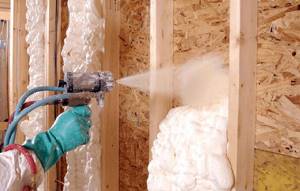
Composition of penoizol
During the manufacture of this material, inexpensive components are used, making it affordable. Production requires the use of the following components:
- urea-formaldehyde resin;
- foaming component;
- orthophosphoric acid;
- water.
All this is put into a foam generator, to which compressed air is supplied. This device forms a foamy mass with which the voids are sealed. Modified mettemplast is a white substance with a jelly structure. Hardening of the applied composition occurs after 10 minutes, after 4 hours the mass becomes solid. Final strength occurs after three days.
Characteristics of penoizol
This insulation is characterized by the following qualities:
- Ability to conduct heat
. Polymer foam has a coefficient from 0.031 to 0.041 W/m²K. The layer can be from 5 cm to 1 m. - Fire resistance
. The material has a flammability group of G-1, and a flammability group of B-2. This means that penoizol not only does not burn, but also does not melt. The insulation can be used in the following temperature range: from -60˚ to +80˚С. - Chemical and biological resistance
. Penoizol is not afraid of fungus and other biological microorganisms. In addition, the material does not react to aggressive chemical environments and organic solvents. - Moisture resistance and breathability
. Moisture is absorbed and released without consequences. After drying, the quality is not lost. The hygroscopicity of the material helps it “breathe”. - Strength and durability
. The soft structure makes the insulation adaptable and helps it adhere well to the surface, filling all corners. High bending strength. Operational life - 30 years.

What kind of thermal insulation material is this?
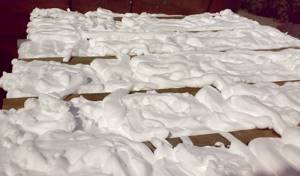
Let's start with definitions. The name "Penoizol" is a trademark of insulation created on the basis of urea resins. The material is in high demand, so it has become a household name, combining the following names:
- "Teploizol"
- "Mipora"
- "Unipor"
- "Mettemplast"
However, among professional builders, insulation is better known as liquid or poured foam.
In appearance, thermal insulation resembles marshmallows, which, after hardening, turns into an elastic mass that is guaranteed to fill all voids.
The composition of the insulation includes the following components:
- Urea resin
- Orthophosphoric acid
- Foaming additives
The ingredients are mixed in certain proportions and pumped into special cylinders where the mixture is under pressure.
Types of penoizol
Might be interesting
Modern technologies have made it possible to create several types of materials, each of which has its own characteristics and differences. When foaming walls with foam insulation, this is also taken into account.
Liquid
Widely distributed in various spheres of life. A very convenient option due to the fact that it can be prepared directly on construction sites. Helps with repairs, provides protection against heat penetration. To additionally form sound insulation in frame buildings, foam is poured inside a confined space. During repairs, available penoizol helps fill cracks and gaps. It can also insulate.
Granulated
It is also called thermal wool or foam insulation crumbs. Release form: granules with a high degree of elasticity. During manufacturing, the polymer is crushed into fractions, each of which is 15 mm in size.
Compared to the original quantity, the volume of this mixture doubles after such grinding. A good option for those interested in cost-effective installation. Granular penoizol is laid on the floor, and the cavities between the walls are filled with it. The ceiling is easy to process.
Sheet
It involves pouring into a special form, in liquid form. The base is cut on special machines when everything cools down. Or they do everything with their own hands to give the structures the required shape and thickness. Next comes drying with mechanical processing. Insulation of buildings under construction is the main purpose of such materials.
During installation, dowels are used to cover the outer walls. The top of the wall is covered with decorative coverings. Slabs are also laid between the joists on the floor after producing penoizol with your own hands at home.
Tips and tricks
In order to reduce the costs associated with the thermal insulation of a structure, you can not purchase ready-made equipment, but install it yourself at home. Such a device must have:
- gas-liquid unit;
- hoses for supplying reagents and foam;
- plastic containers;
- compressor;
- taps.
A diagram of self-installation of the installation is shown in Fig. 1.
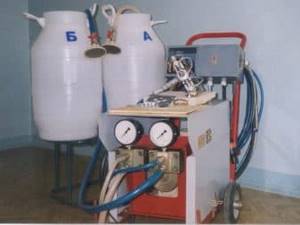
Installers advise working with penoizol according to this scheme:
- assembling the installation in accordance with the instructions;
- mixing all the necessary components in a barrel;
- preparing the surface to be treated by dismantling old facing materials (the base does not need leveling: a layer of liquid foam can hide all bumps, protrusions and other flaws);
- installation of metal or wooden sheathing (wooden structures must be treated with antiseptic compounds);
- installation of logs from wooden beams;
- applying a uniform layer of penoizol or foaming voids;
- cutting off excess material with a construction knife after it has hardened;
- installation of reinforcing mesh after polymerization of insulation;
- facing works.
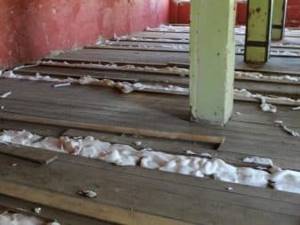
In order to install a heat insulator efficiently, it is best to contact certified installation organizations.
Craftsmen are able to quickly insulate any structure and provide a guarantee for the work done.
The difference between polyurethane and polystyrene
The closest analogue of polyurethane foam is polystyrene foam, which has similar characteristics and is also used for insulating various surfaces.
Expanded polystyrene belongs to the group of slab insulation materials that are made by foaming. Expanded polystyrene also has many advantages compared to many other slab insulating elements. But at the same time, the functionality of this material is slightly limited when compared with polyurethane foam.
Expanded polystyrene cannot be used for spraying pipes, ventilation ducts and, in general, any elements that have complex geometry. But at the same time, you can apply this material yourself, whereas this cannot be done with polystyrene foam.
To apply PPU foam, it is necessary to use special equipment, which, as a rule, is only available to construction teams of workers. Of course, there is an option to apply polyurethane foam using small cylinders, but it will not be effective if it is necessary to apply insulation over a large area.
Consumption rates for insulating material per 1m2
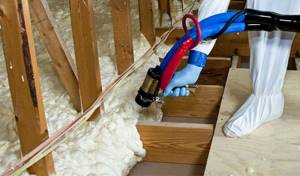
When planning a construction budget, you need to accurately determine the amount of material. To determine the amount of liquid insulation that will be required to insulate the entire building, you need to know the consumption rates of penoizol per square meter.
According to manufacturers, the consumption of liquid foam per 1 m2 varies between 1-1.3 liters.
To calculate the required amount of material, you need to multiply the length and width of the wall by the consumption rates stated by the manufacturer. For example: 7*3.2*1.3=29.12 l. In this case, the final amount of thermal insulation must be taken with a small margin, taking into account unforeseen situations.
Flaws
The main disadvantages are different: penoizol is not suitable for all structures; it should act only as a middle layer and be reliably protected from external factors.
Penoizol gives significant shrinkage (1-3% of volume). Since penoizol can only be installed at a certain temperature, this may cause a delay in construction work, which is also a disadvantage.
Please note: penoizol can only be installed at an air temperature of 6 degrees or more.
Despite the fact that pouring insulation does not take much time, this work must only be performed by a specialist, otherwise the material may lose its properties.
Penoizol must be insulated. In addition, it is often necessary to additionally insulate the material in the structure, which leads to unnecessary costs.
If this has not been done, the insulation may release formaldehyde gas, which causes an allergic reaction in people.
It is the poor quality of work and material that causes negative reviews.
Be careful: before purchasing, you should make sure that the manufacturer is reliable and has quality certificates; beware of counterfeits.
This article is about the features of equipment for the production of penoizol.
Read the article about making penoizol with your own hands here.
Advantages and disadvantages
Liquid foam has numerous advantages that distinguish it from other types of heat insulators.
This material has the following advantages:
- Low thermal conductivity coefficient.
- Elasticity and resilience. Thanks to these properties, the foam fills all cracks and voids, eliminating the formation of cold air bridges.
- Resistant to mechanical stress. Under force loads, the frozen material is crushed, and after the pressure is removed, it quickly returns to its original position.
- Resistant to sudden temperature changes and resistant to changes in humidity.
- Excellent steam permeability. Due to this property, condensation will not accumulate on insulated wall surfaces.
- Good adhesion. The foam quickly and reliably adheres to any of the bases, making it convenient for insulating buildings with complex structures.
- Excellent protection against mold and mildew. You don’t have to be afraid that insects will get into the insulation or that rodents will ruin it.
- Favorable price. The raw materials for the production of penoizol are inexpensive, which has a positive effect on the prices of the finished material. By installing a heat insulator yourself, you can save a significant amount on home insulation.
- Durability. Properly installed thermal insulation material can last more than 50 years without changing its performance properties.
- Environmentally friendly. During operation, the heat insulator does not emit harmful substances. It is safe for health.
Despite the above advantages, liquid foam cannot be called an ideal insulation material. It has some disadvantages.
Reviews from those who insulated their home with penoizol indicate shrinkage of the material (approximately 5%). The disadvantages include the impossibility of preparing and applying a foamy mass without specialized equipment.
It can be rented or purchased, and this leads to additional financial costs.
Penoizol
Penoizol is a heat and sound insulator based on hardened carbamide resin. In working circles you can hear the following names for the material: foamed or liquid foam plastic, poured plastic. Other name options: eco-insol or teploizol (due to its properties). Used in solid and foam states.

Insulation of internal walls with foam insulation
In solid form, it resembles foam plastic, only without large air bubbles. A white foam-like form is obtained by mixing urea resin, foaming agent and phosphoric acid and then pouring water. This mixture is actively used when filling cavities in building structures.
This material differs from others in its special insulation characteristics:
- Compression of a substance at low density is applicable when insulating walls. To do this, the substance is brought to a liquid state and tightly poured into construction voids, cracks and gaps. Even hard to reach ones. Hardens only on contact with air after 15 minutes;
- Low thermal conductivity;
- In a solid state at high density, eco-isol can withstand the weight of a person;
- Due to its chemical composition, it is not attractive to rodents and microorganisms;
- In case of minor deformations, we will restore the material to its previous condition;
- Service life (more than 50 years) depends on compliance with recommendations;
- Doesn't rot. Therefore, it is beneficial for insulation on the outside of the building;
- Resistance to fire and temperatures (+120 - -50°) is in demand in many areas. Especially when using flammable items. Penoizol does not melt, does not burn or smoke;
- Absorbs sounds and noise from the streets or neighbors;
- It is a breathable thermal insulator;
- Harmless water absorption is up to 20%. Moisture does not remain for a long time due to the porous surface of the material;
- Chemical resistance to various active substances.
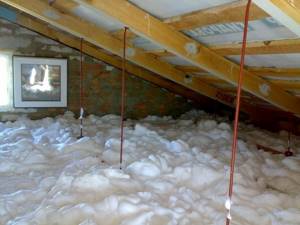
Roof insulation Such properties make it possible to efficiently and quickly insulate a private house with foam insulation. But, like everything, it has its drawbacks. These include
- Due to the relationship between density and volume, severe shrinkage is detected during hardening. Even with well-carried out installation work, voids may form when penoizol hardens;
- Installation work becomes more complicated due to shrinkage of the insulation. Knowledge and practice, strict adherence to the technology of applying penoizol are important;
- Ecoizol is protected by another substance on the outside to avoid chipping in the solid state;
- Special equipment is required for installation;
- It is advisable to carry out work outdoors at temperatures from +15 to 20. The street temperature does not affect interior work;
- Possible long-term accumulation of rain moisture and reduced thermal insulation;
- The use of poor quality material leads to an unpleasant odor.
Thermal insulation of the façade with foam insulation and cladding with cladding slabs
This method of insulation is used only for exterior decoration of the house. The scheme of work is as follows:
- The number of slabs, galvanized steel profiles or other elements for the entire facade is calculated. A galvanized steel frame is attached to the facade of the building with dowels and screws. That is, it is a metal cladding attached vertically;
- Plates (metal or plastic facing panels) are installed and secured to the frame;
- Holes of 35-40 mm are made in the casing at a distance of about 2 m from each other. Penoizol is poured into them using a pump;
- The holes are filled in a checkerboard pattern from bottom to top.
- After completion of the work, the drilled holes are sealed;
- The façade is being decorated.
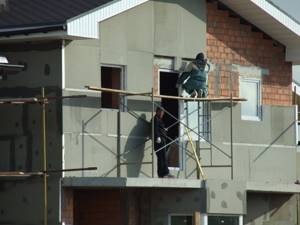
Each of the above methods of insulating a house with foam insulation has its own advantages, but they are all united by an unusual insulation with excellent thermal insulation characteristics.
How to choose material
There is a wide range of foam insulation materials on the market. European foam insulation intended for walls guarantees high quality, but has a high price. Domestic manufacturers have well mastered the production of licensed compounds and materials of their own design, which provide decent quality thermal insulation and a guaranteed service life at a significantly lower price. Experts highlight such manufacturers as
- "Dau-Izolan";
- NVP "Vladipur";
- "ChemSupplier Don";
- "Elastokam";
- CJSC "Uretan";
- "Khimprom".
Their advantage over nameless Chinese crafts is their precisely known composition and quality control at all stages of production.
When choosing foam intended for insulating external walls, you should check whether the specific material is recommended for outdoor use, whether it matches the density of the equipment available and the final calculated density of the foam.
And if saving on equipment is even more or less reasonable - it will only be useful once, then it’s definitely not worth saving on materials.
Price
One of the main advantages of the presented insulation is its price. Penoizol costs about 600 rubles/m³. At the same time, the quality of thermal insulation is not inferior to the popular insulation materials existing on the market today.

If we compare penoizol with mineral wool, a product with similar thermal conductivity will cost the consumer 1.5 times more. Moreover, the price of this insulation is 900-1000 rubles/m³.
The price of penoizol is 1.5 times lower than the cost of polystyrene foam. Material with similar thermal conductivity costs 950-1000 rubles/m³. The cost of extruded polystyrene foam is 6.6 times higher than that of penoplex. It is about 4 thousand rubles/m³ (taking into account the thermal conductivity coefficient).
Also, in terms of cost, urea foam is more profitable than basalt slabs, staple fiber and expanded clay. For this reason, many private property owners prefer this type of material.
Manufacturers of urea foam plastic in the Russian Federation
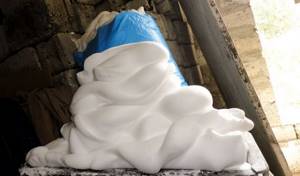
Many companies in Russia and Europe are engaged in the production of penoizol. However, to purchase quality material you need to take a responsible approach to choosing a manufacturer
Therefore, we advise you to pay attention to the products of such companies:
- "New construction technologies". The company was founded in 1990 and specializes in the production of thermal and waterproofing, fiberglass, and fiber-reinforced concrete. Today, this is one of the main suppliers of penoizol on the Russian market. By the way, the rights to use this trademark belong to this. This is a British company engaged in the production of liquid insulation flotofaum - the name of penoizol.
- LLC "Uveis" Russian company located in the city of Orenburg. The manufacturer has been working on the market for a long time, so it carefully monitors the quality of its products.
In addition, buyers speak positively about the products of ProTeplo LLC, Penoizol-Omsk LLC, and Murmansk Universal Plant CJSC.
Installer reviews
The characteristics of penoizol determine its method of application. After the mass comes out of the unit’s sleeve, it hardens. However, this process occurs gradually. The material sets to the base 10 minutes after application. In this state, penoizol remains soft.
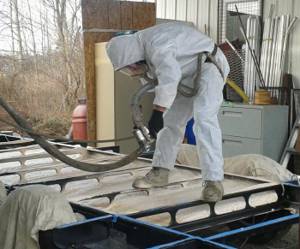
After another 4 hours, the mass hardens. It becomes quite hard. However, penoizol has not yet gained strength. It will take a few more days for the thermal insulation to be ready for subsequent finishing. It gains strength within 3 days. During this time, Penoizol acquires all its positive qualities.
Professional installers claim that thermal insulation of this category is installed much faster than other insulation materials. The surface processing speed will be 4-5 times higher. Moreover, the material is lightweight. It slightly makes the structure heavier.
Disadvantages of penoizol
Compared to expanded polystyrene, this material has the following disadvantages:
- lower mechanical strength, so the coating is sensitive to impacts and other damage,
- shrinkage from 0.2 to 4%, which requires supplying the solution under pressure. Standard density and shrinkage are ensured by strict adherence to technological parameters - pressure and temperature during pouring,
- During the period of pouring, polymerization and drying, gaseous formaldehyde with a pungent odor is released. Therefore, good ventilation is required when carrying out work. Maximum permissible values of harmful substances are reached after 2-3 weeks,
- Under the influence of direct sunlight and heat, penoizol decomposes into formaldehyde and urea. Therefore, it is not recommended to use it in the under-roof space,
- its open-pore structure determines its high moisture absorption capacity, which limits its use in the underground part of foundations and requires moisture insulation in the above-ground part.
The application technology requires special equipment and if the proportions of the components are violated, significant shrinkage is possible. The application of foam should be carried out in one step, without frozen joint areas. Complete hardening time is 3-5 days.
The thermal insulation properties are slightly superior to expanded polystyrene and a layer of foam insulation 10 cm thick is similar in thermal conductivity to a sheet of expanded polystyrene with a density of 15 kg/m 3 and a thickness of 12.5 cm.
This material, unlike polystyrene foam, does not like mice to settle in. But this only speaks of its controversial environmental friendliness and the release of harmful substances from it. Therefore, insulating houses with penoizol requires careful insulation of all surfaces with applied polymer, for example, plastering.
When constructing houses or reconstructing them, the question of effective wall insulation often arises. For these purposes, many materials are produced that are different in their technical characteristics, properties, performance and cost. Recently, penoizol or urea-formaldehyde foam has become increasingly popular in the domestic market.
Technical characteristics of urea-formaldehyde foam (UFP)

It is believed that, in terms of its stated performance properties, penoizol is superior to any insulation available on the domestic market. The main characteristics of thermal insulation look like this:
- Thermal efficiency . The thermal conductivity of insulation varies between 0.031-0.041 W/m on the Kelvin scale. 10 cm layer of liquid foam to provide reliable insulation to the interior.
- Soundproofing . Penoizol absorbs up to 65% of street noise, which is considered a very good indicator.
- Fire safety . The material is not flammable and does not support combustion. However, when exposed to high temperatures, the insulation will simply evaporate without releasing toxic substances into the air.
- Dependence on chemical and biological factors . The insulation is neutral to any aggressive environment. In addition, the insulation is of no interest to rodents and is resistant to pathogenic microflora: fungus, mold.
- Moisture resistance . The material absorbs moisture well, but subsequently evaporates it without losing its original properties. Given this feature, it is recommended to install ventilation gaps to prevent the appearance of mold on the walls.
- Durability . Indicators of linear compression of insulation are 0.07-0.5 kg/cm2 . Accordingly, the material holds its shape well and quickly restores its structure.
Manufacturers claim that thermal insulation can last 30-50 years without loss of quality. However, insulation appeared on the market relatively recently, so there is no evidence of such an impressive service life yet.
Harmful or not?
According to numerous reviews online, most consumers of liquid foam complain about its toxic odor during installation and drying. As experts note, such situations are observed when purchasing a low-quality heat insulator. The fact is that some manufacturers, in order to save money, use cheap urea resin with numerous impurities.
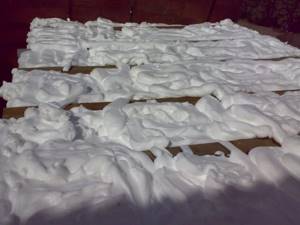
A high-quality heat insulator may emit an unpleasant odor only during installation. This is explained by the fact that during polymerization the substance begins to release formaldehyde. However, their number is insignificant. In comparison, many modern paint products emit much more harmful substances, while penoizol manufactured according to standards ceases to emit formaldehyde even after drying.
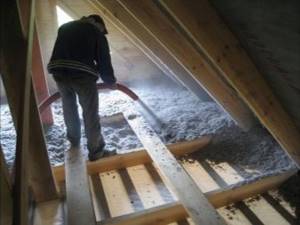
Read with this
- Insulation with liquid foam plastic
- Facade made of corrugated sheets
- How to insulate walls using expanded clay?
- Interventional insulation for timber and logs
- How and how to insulate a wooden house from the inside
- How to insulate an aerated concrete house from the outside?
- Do-it-yourself insulation of a sauna from the inside using different materials
- Do-it-yourself insulation of the garage roof from the inside and outside: subtleties of construction work
- Roll insulation: soft and self-adhesive, plate or rolls, thermal insulation for walls 150 mm, types and properties of thermal insulation materials
- Technical characteristics of penofol - a universal heat insulator
Rules for pouring liquid foam

In order for penoizol to fully live up to the hopes placed on it, it is necessary to strictly adhere to the pouring technology. If this is your first time dealing with liquid thermal insulation, it is better to immediately contact specialists who can do the job efficiently.
Wall insulation is carried out according to the following scheme:
- Holes are drilled in the wall structures, into which penoizol is pumped through filling hoses.
- Install a protective facade made of metal profiles, leaving a gap of 5-10 cm between the wall and the metal.
- Fill the free space with insulation.
- Wait 4 hours for the material to set, cut off excess insulation, and begin finishing.
Roof insulation:
- The surface intended for insulation is covered with a film, which should extend 10-15 cm .
- Fix the membrane with staples.
- The slats are stuffed on top of the film.
- The space between the slats is filled with insulation.
- Wait 15-20 minutes for the insulation to become viscous and level the surface.
- After 4 hours, you can begin further work.
Floor insulation:
- Wooden sheathing is being installed.
- All sections are filled with insulation.
- When the material hardens, a plastic film is placed on top.
- Finishing is carried out: boards are laid or concrete is poured.
In principle, working with penoizol is practically no different from installing other types of insulation.
Independent reviews from construction forums
To understand the real effectiveness of insulation, you should not unconditionally trust the words of sellers and manufacturers. It will be much more effective to turn to the reviews of real people who have already used the subject of our conversation for insulation. Let us immediately note that opinions on the properties of liquid thermal insulation are divided.
Not bad, but there was a small nuance. Alexander (www.forumhouse.ru)
Penoizol is an excellent alternative to any type of modern insulation. The price is quite reasonable, the mice will not be stolen, the declared characteristics are at a high level. However, during practical use, a small drawback emerged: when insulating wooden walls, unfilled areas remained.
Recommended by friends. The house has a comfortable microclimate. Ildar (mastergrad.com)
We decided to insulate the walls with foam insulation about 5 years ago: the outer wall is made of block and brick. 6-7 centimeters left between the masonry . Glass wool and mineral wool did not give the expected result: the wall began to mold, the rooms were quite cool.
Friends recommended penoizol. As the crew worked, one could hear and see the insulation filling the space between the walls, emerging from the cracks. Now the house maintains a comfortable microclimate at any time of the year.
Negative reviews
In various sources you can find many positive and negative reviews about penoizol. Those who have insulated their home with this material are in most cases satisfied with the result. However, there are also negative reviews.
After pouring penoizol, its shrinkage ranges from 0.1 to 5%. This is an insignificant indicator. However, if the professional training of the master is insufficient or if low-quality material is used, this figure may increase.
There are also reviews about the unpleasant odor of the insulation, which appears during the drying process. This phenomenon occurs only in low quality products. Do not contact dubious installation organizations. When penoizol dries, a small amount of formaldehyde may be released. However, its quantity is insignificant. It is enough to leave the windows in the room open to quickly get rid of the unpleasant odor when the insulation hardens.
Positive reviews
Minor shortcomings of penoizol cannot affect its demand and ever-growing popularity. Many positive reviews from those who installed the presented material at home, speaking about the high quality of the insulation.
When used, the room becomes much warmer. Energy bills decrease in winter. At the same time, the room becomes warm and the humidity level is maintained at a level optimal for human health.
Installation is very fast. Moreover, the cost of such finishing will be several times less than when using other types of insulation.
